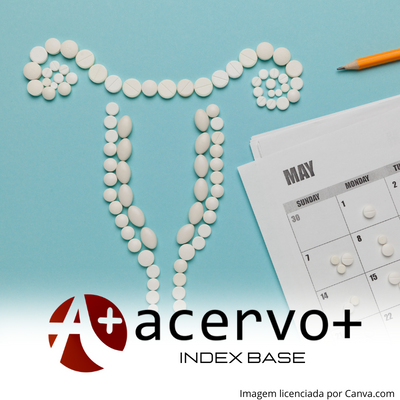Função sexual em mulheres com ovários policísticos que utilizam anticoncepcionais orais
##plugins.themes.bootstrap3.article.main##
Resumo
Objetivo: Investigar os efeitos da SOP na qualidade de vida das mulheres em relação a função sexual de portadoras de SOP que fazem uso de anticoncepcional oral. Métodos: Trata-se de um estudo epidemiológico do tipo observacional de coorte retrospectivo, conduzido em ambiente virtual com 50 mulheres portadoras de SOP que utilizam anticoncepcionais orais. Foram investigadas quanto à sua função sexual através do Índice de Função Sexual Feminina (FSFI). Dados obtidos foram analisados por estatística descritiva com auxílio do software. O estudo foi aprovado pelo Comitê de Ética em Pesquisa. Resultados: Das 102 respostas obtidas somente 45 utilizavam anticoncepcionais orais há mais de 3 meses e possuíam SOP. Dessas, 20 utilizavam anticoncepcionais orais com concentração de etinilestradiol maior ou igual a 0,035mg. Mulheres que apresentam SOP e utilizam anticoncepcionais com essa concentração obtiveram maiores escores de FSFI do que aquelas que utilizam anticoncepcionais com concentrações menores. O risco relativo da exposição a concentrações maiores que 0,035mg foi de 0,75. Conclusão: Conclui-se que os anticoncepcionais orais afetam a função sexual das pacientes de diferentes maneiras e a SOP é um fator que agrava essa situação. Sugere-se o aprofundamento das investigações sobre o tema estudado.
##plugins.themes.bootstrap3.article.details##
Copyright © | Todos os direitos reservados.
A revista detém os direitos autorais exclusivos de publicação deste artigo nos termos da lei 9610/98.
Reprodução parcial
É livre o uso de partes do texto, figuras e questionário do artigo, sendo obrigatória a citação dos autores e revista.
Reprodução total
É expressamente proibida, devendo ser autorizada pela revista.
Referências
2. BAHAMONDES L e BAHAMONDES MV. New and emerging contraceptives: a state-of-the-art review. Int. J. Womens. Health. 2014; 6.
3. BARACAT MC e REZENDE GP. Qualidade de vida e função sexual em mulheres com SOP. In: Síndrome dos ovários policísticos. São Paulo: Federação Brasileira das Associações de Ginecologia e Obstetrícia (FEBRASGO). 2023; 3: 46-64.
4. BERNARD L, et al. "Quality of life and psychological well being in polycystic ovary syndrome." Human reproduction. 2007; 8(6): 2279-2286.
5. CASADO-ESPADA NM, et al. Hormonal Contraceptives, Female Sexual Dysfunction, and Managing Strategies: A Review. J Clin Med. 2019; 25(8): 908.
6. CESTA CE, et al. Polycystic ovary syndrome and psychiatric disorders: Comorbidity and heritability in a nationwide Swedish cohort. Psychoneuroendocrinology. 2016; 73: 196-203.
7. DAVIS SR, et al. Endocrine aspects of female sexual dysfunction. J Sex Med. 2004; 1(1): 82-86.
8. FEBRASGO. Federação Brasileira das Associações de Ginecologia e Obstetrícia Tratado de Ginecologia. Rio de Janeiro: Grupo GEN. 2018; 998.
9. GOMES PD, et al. Contracepção hormonal: uma comparação entre pacientes das redes pública e privada de saúde. Ciênc. saúde coletiva. 2011; 16(5): 2453-2460.
10. HASEGAWA LEM, et al. A relação entre o uso de anticoncepcionais hormonais e a sexualidade feminina: uma revisão integrativa. Research, Society and Development. 2022; 11(4): e12711423238.
11. IMPRIALOS, K.P, et al. Sexual Dystunction, Cardiovascular Risk and Effects of Pharmacotherapy. Curr. Vasc. Pharmacol. 2018; 16: 130-142.
12. IZZO CR. Infertilidade de causa hormonal para o ginecologista. Boletim da SBRH. São Paulo. 2008; 6(2): 1-8.
13. LIDDELOW C, et al. Adherence to the oral contraceptive pill: the roles of health literacy and knowledge, Health Psychology and Behavioral Medicine. 2020; 8(1): 587-600.
14. MANTZOU D, et al. Sexual Function in Young Women With PCOS: The Detrimental Bffect of Anovulation. J Sex Med. 2021; 18(11): 1872-1879.
15. MEDEIROS AJG, et al. Abordagem do diagnóstico e tratamento da síndrome dos ovários policísticos. Revista Eletrônica Acervo Saúde. 2023; 23(8): e13503.
16. MURGEL FCA, et al. Sexual Dysfunction in Women With Polycystic Ovary Syndrome: Systematic Review and Meta-Analysis. The Journal of Sexual Medicine. 2019; 16(4): 542-550.
17. PASTOOR H, et al. Sexual Function in Women With Polycystic Ovary Syndrome: Design of an Observational Prospective Multicenter Case Control Study. Sex Med. 2020; 8(4): 718-729.
18. POKORA K, et al. Depressive Symptoms and Control of Emotions among Polish Women with Polycystic Ovary Syndrome. Int J Environ Res Public Health. 2022; 19(24): 16871.
19. RASHID RSA, et al. Polycystic ovarian syndrome-current pharmacotherapy and clinical implications. Tawainase Journal of Obstetrics & Gynecology. 2022; 61: 40-60.
20. MORAES LU, et al. As Bases do Diagnóstico Sindrômico. São Paulo: Editora Científica Digital. 2023; 1: 338p.
21. SHAKEEL M, et al. Sexual functioning as predictor of depressive symptoms and life satisfaction in females with Polycystic Ovary Syndrome (PCOS). Pakistan Journal of Medical Sciences. 2020; 36(7): 1500-1504.
22. SILVA RC, et al. Síndrome dos ovários policísticos, síndrome metabólica, risco cardiovascular e o papel dos agentes sensibilizadores da insulina. Arq Bras Endocrinol Metab, São Paulo. 2006; 50(2): 281-290.
23. SOUZA MS, et al. "Anticoncepcionais hormonais orais e seus efeitos colaterais no organismo feminino: uma revisão integrativa: Oral hormonal contraceptives and their effects colateral in the female organism: an integrative review." Journal of Education Science and Health 2.2. 2022; 01-11.
24. SPEER JJ, et al. Study of sexual functioning determinants in breast cancer survivors. Breast J. 2005; 11(6): 440-7.
25. SPRITZER PM. Polycystic ovary syndrome: new insights on the puzzle of adiposity, chronic low-grade inflammation and metabolic disturbances. Arch. Endocrinol. Metab. 2020; 64(1): 2-3.

